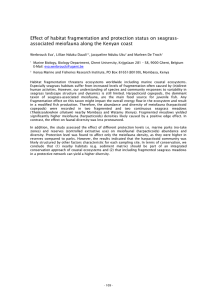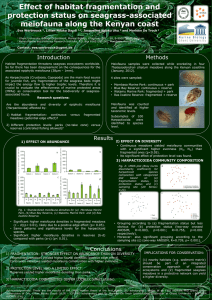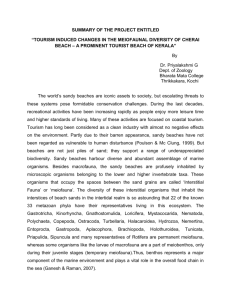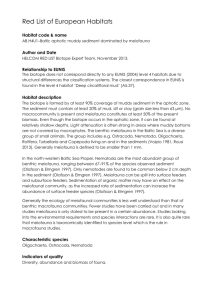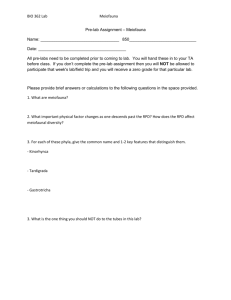CHAPTER III 112867
advertisement
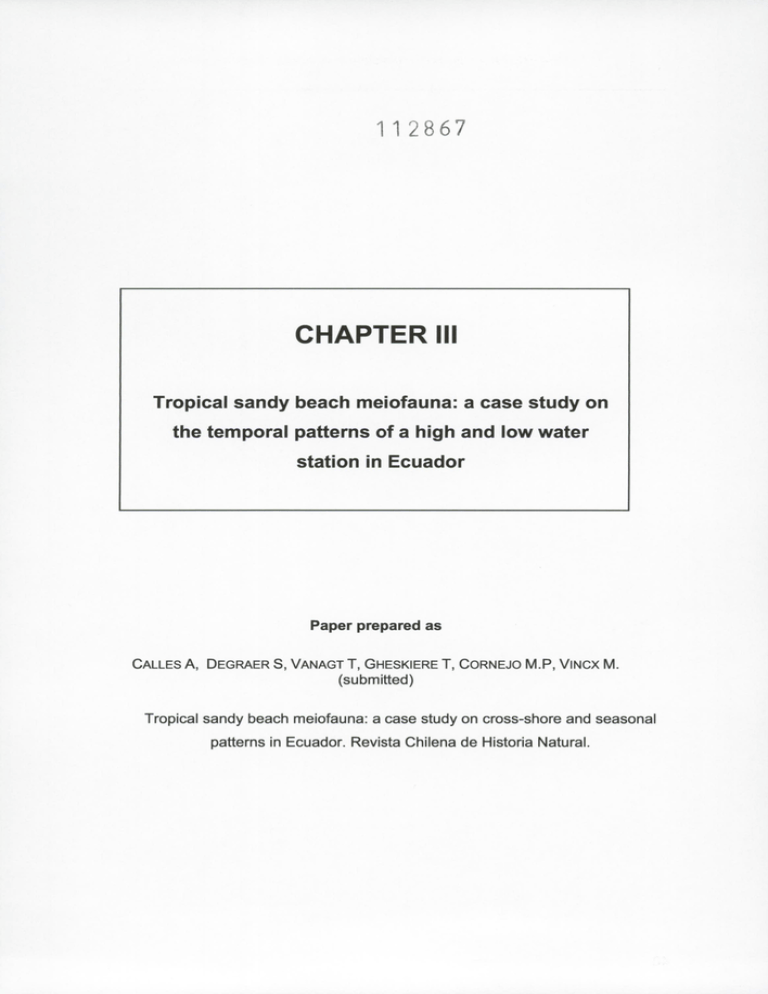
112867 CHAPTER III Tropical sandy beach meiofauna: a case study on the temporal patterns of a high and low water station in Ecuador Paper prepared as CALLES A, DEGRAER S, VANAGT T, GHESKIERE T, CORNEJO M.P, VINCX M. (submitted) Tropical sandy beach meiofauna: a case study on cross-shore and seasonal patterns in Ecuador. Revista Chilena de Historia Natural. CHAPTER III: Meiofauna study on "cross-shore" and temporal patterns in Ecuador ABSTRACT The meiofauna on a cross-shore gradient at an intermediate-reflective Ecuadorian sandy beach was studied fortnightly from June 2000 until July 2001 (this period had undergone a strong La Nina event), in order to analyse the patterns in abundance between upper and lower station at the intertidal zone and to assess the temporal variability in view of seasonality (dry versus rainy season). The sea surface temperature ranged between 21.4 and 27.5 °C, the pluviosity was restricted between January and March 2001 (151-114 mm), the salinity ranged between 32 and 34 PSU and the median grain size between 215 and 290 pm at the upper station and 191-301 at the lower station, corresponding to fine-medium sand. The meiofauna samples were collected with plastic cores (3.6 cm diameter) to 20 cm depth. Fifteen meiofauna taxa were registered, with Nematoda the dominant taxon on the beach (61% at the upper station and 83% at the lower station). The total meiofauna density ranged from 186±14 ind./10 cm 2 to 3907±408 ind./10 cm 2 at the upper station and from 417±5 ind./10 cm 2 to 1940±166 ind./10 cm 2 at the lower station; however no significant differences on the average meiofauna densities were detected between the stations. Multi-dimensional scaling ordination based on higher meiofauna taxa densities showed cross-shore differences, caused by highest densities of copepods at the upper station (275±86 ind./10 cm 2 ) and highest densities of nematodes (738±64 ind./10 cm 2 ), with a near absence of copepods at the lower station. At the lower station the total meiofauna and nematode densities showed a significant negative correlation with the distance (as a proxy for elevation): a decreasing density was found lower on the beach; and a significant positive correlation with the rainfall. A seasonal respond to the total meiofauna and nematodes at the lower station were detected. At the upper station no correlation were found. Compared with other cross-shore patterns illustrated in the literature, the nature of the meiofauna data from the Ecuadorian beach increases even at the high spatial and temporal variability of the interstitial meiofauna present in different sandy beaches around the world. Therefore, there is not something like a 'typical' sandy beach meiofauna. KEY WORDS: meiofauna, Ecuador, intertidal zone, intermediate-reflective beach, temporal variability, tidal level. 43 CHAPTER III: Meiofauna study on "cross-shore" and temporal patterns in Ecuador INTRODUCTION In the intertidal beach, physical variables such as temperature, movement of sediment and salinity are more variable than in the subtidal, and may greatly influence the faunistic composition and distribution within and between intertidal areas (HICKS AND COULL, 1983). MCLACHLAN AND TURNER (1994) described the intertidal environment of sandy beaches as a continuum with at one extreme the coarse-grained, reflective beach state characterized by high water percolation and, consequently, high oxygenation, and at the other extreme dissipative beaches with finer sands and a lower permeability which tend to harbour higher organic inputs and anaerobic conditions. Exposed sandy shores are often considered to be merely an edge of the sea or the land, but they also constitute an important ecotone with food chains based on decomposers, grazers and suspension feeders (MCLACHLAN, 1981). The physical harshness of the eroding, intermediate shore may be counterbalanced by oxygen-rich conditions. On the accreting, dissipative shore a pronounced chemocline (sharp gradient in chemical concentration) favours a dominance of nematodes (MENN, 2002). Differences in availability of major food resources between the shores may also affect the meiofauna. The longer the period between swashes, the better the conditions for the fauna on exposed sandy beaches. MCLACHLAN et al. (1993) have suggested that the swash climate directly controls the composition and structure of the sandy beach communities. The interstitial fauna of marine beaches has been studied at different latitudes and localities (e.g. HEIP et al., 1985 for an overview; COULL, 1988) but not so much along cross-shore and temporal gradients in tropical areas (GOURBAULT et al., 1998). From the South-eastern Pacific region no data on interstitial fauna are available for sandy beaches. This study provides the first information about the meiofauna composition and their distribution at the intertidal zone in the Ecuadorian sandy beach over a one year period. The aims of this study were: 1. to contrast the density and composition of intertidal meiofauna at the upper and the lower part of an exposed Ecuadorian sandy beach; 2. to assess the temporal variability from June 2000 until July 2001, in view of seasonality (dry versus rainy season) and 3. to investigate the effect of the environmental variables such as pluviosity, temperature, salinity, distance (as a proxy for elevation) and median grain size on the structuring of the meiofaunal community. The study period undergone a strong La Nina phase, after the 1997-98 El Nino (McPhaden, 1999). 44 CHAPTER III: Meiofauna study on "cross-shore" and temporal patterns in Ecuador MATERIAL AND METHODS Study site The beach of San Pedro de Manglaralto is part of the denominated cove San PedroMontanita and is an exposed sandy beach that displays a concavity with direction SONE. The sampling station was located at the southern limit of the Centro Nacional de Acuicultura e Investigaciones Marinas (CENAIM), (1°56'30"S, 80°43'30"W) (Figure 3.1). The beach has a semi-diurnal, mesotidal regime (DAviEs, 1964) with a tidal range between 2-2.4 m. The Ecuadorian coastal climate is characterized by two seasons: a dry-cool season (May-December) and a wet-warm season (January-April) and is influenced by currents in the Pacific Ocean. From July until October the area is subjected to the relatively cold (<22 °C) Humboldt-current, heading North, while during the months January until April the warm (>25 °C) El Nifio-current, heading South, dominates. In addition, wide inter-annual fluctuations of the weather can occur due to the ENSO phenomenon (FIEDLER, 2002). -82' -80° -78' -76 -74° 4° COLOMBIA 2° 0° ECUADOR Study Site San Pedro PACIF ICOC EAN \ de Manglaraho Gelb a. Ousyspol PERU -6 ° Km 200 0 -82° Figure 3.1 -80° -78' -76° -74° Location of the study site. 45 CHAPTER III: Meiofauna study on "cross-shore" and temporal patterns in Ecuador Sampling strategy and laboratory work Sampling was performed fortnightly from June 2000 until July 2001 at spring tides (full moon and new moon). At the beach two stations were sampled: one at low and one at high tide level. The position of both stations was assessed based on predicted time and elevation of high and low water (La Libertad data, Institute Oceanografico de la Armada). At each station, three replicate samples were collected for meiofauna samples. They were obtained by forcing a hand core (3.6 cm diameter) (HIGGINS AND THIEL, 1988) to 20 cm depth in the sediment and fixed with a heated (60 °C) 4% buffered aqueous formaldehyde solution (Vinicx, 1996). Additional sediment samples were collected for granulometric analyses. Sea Surface Temperature (SST) and salinity data were taken from the nearby 'El Pelado' Oceanographic station (01° 55' 53" S, 80° 46' 55" W), and pluviosity data from the CENAIM-ESPOL (Escuela Superior Politecnica del Litoral) foundation. Sediment particle-size distribution was determined using Coulter LS 100 © particle size analyzer. The sediment fractions were defined according to the Wentworth scale (BUCHANAN, 1984). At each sampling location the beach profile was measured as the difference in elevation every 5 meters along the transect using a leveller from a fixed reference point (0) localized in front of CENAIM. The distance is used as a proxy for elevation. In the laboratory, meiofauna samples were rinsed with a gentle jet of freshwater over a 1 mm sieve to exclude macrofauna, decanted ten times over a 38 pm sieve, centrifuged three times with Ludox © HS 40 (specific density 1.18) and stained with Rose Bengal. Meiofauna was counted by using a counting dish and identified at the higher taxon level under a stereomicroscope. The presence of archiannelids (Polychaeta) was observed in the samples but it was not possible to include them in the counting because the specimens were fragmented. 46 CHAPTER III: Meiofauna study on "cross-shore" and temporal patterns in Ecuador Data analysis Beaches can be classified by three variables: The modal breaker height (H b ), in meters; the modal wave period (T), in seconds; and sediment fall velocity (W s ), in meters per second. The Ws was calculated from the median grain size following GIBBS et al. (1971). The values to this study were: Hb= 0.4 m, T= 3 s and Ws= 0.03 m/s. These parameters were combined into the dimensionless fall velocity 0 = H b/ WsT or Dean's parameter (SHORT, 1999). When 0 < 1 beaches tend to be reflective, when 0 > 6 they tend to be dissipative and in between (1 < S2 < 6) are the so-called intermediate beaches (MASSELINK AND SHORT, 1993). The 'dry' (April-December) and 'rainy' (January-March) seasons were defined according to the data set of the sampling year (See figure 3.3). In order to detect temporal and cross-shore patterns in the meiofauna data, the multivariate analyses were done after square-root data transformation. Lower triangular similarity matrices were constructed using the Bray-Curtis similarity measure to find a faunal structure with visual inspection of a clustering dendrogram. Patterns in the meiofauna data were analyzed by non-metric Multi-Dimensional Scaling (nMDS). One-way crossed analysis of similarities or ANOSIM (CLARKE, 1993) was used to test the significant differences in meiofauna assemblage composition between beach stations. The similarity percentage analyzer or SIMPER (CLARKE, 1993) was applied to determine the contribution of higher meiofauna taxa to the discrimination between the beach stations. The multivariate analyses were performed using PRIMER v5 software package (CLARKE AND GORLEY, 2001). The univariate analyses were applied to the average meiofauna densities of three replicates. The faunal densities were expressed in individuals per 10 cm 2 (ind./10 cm 2 ). Analysis of variance (ANOVA) was applied to check the existence of significant differences between dry and rainy season per station. Pearson's correlation was applied to assess the relationship between meiofauna taxa (at the upper and at the lower station) and environmental factors such as pluviosity, temperature, salinity, distance (as a proxy for elevation) and median grain size. The normal distribution of the data was checked by the Kolmogorov-Smirnov test. Levene's test was used to verify the homogeneity of variances prior to the analysis. When conditions for the use of a parametric test were not fulfilled, the nonparametric MannWhitney U test (Z statistic Mann-Whitney Test; p<0.001*** -very highly significant; p<0.01** - highly significant; p<0.05* - significant) was employed at two independent samples. Statistical analysis was performed using the STATISTICA v6.0 software package (STATSOFT, 2001). 47 CHAPTER III: Meiofauna study on "cross-shore" and temporal patterns in Ecuador RESULTS Physical environment The width of the intertidal zone at the different sampling locations ranged from 90 to 120 m. The beach slope varied between 1:21 and 1:41. At the upper station, samples were taken between 34-54 meters from the reference point (0), and at the lower station the sampling distance ranged from 84 to 118 meters (Figure 3.2). In function of the Dean's parameter 0, the study site is an intermediate beach (0 =1.2) but near the reflective characteristics. -0,5 0,0 0,5 - 2,5 UPPER STATION 20 40 LOWER STATION 60 80 100 120 Distance (m) Figure 3.2 Beach profile at San Pedro de Manglaralto (June 2000-June 2001). The indication bars 'upper station' and 'lower station' refer to the sampling distance over which the actual samples were taken during the one year period (cf. text), following the water line at high and low tide level. The vertical scale is exaggerated in relationship to the horizontal. The origin (0) is named reference point in the text. 48 CHAPTER III: Meiofauna study on "cross-shore" and temporal patterns in Ecuador The fine to medium sand fractions dominated the sediment. Median grain size ranged from 215 to 290 pm at the upper station and from 191 to 301 pm at the lower station (Table 3.1). The SST ranged between 21.4 and 27.5 °C and was highest in the rainy season; salinity ranged between 32 to 34 PSU and was lowest in the rainy season; the rainfall was mainly restricted from January 2001 (151 mm) to March 2001 (114 mm) (Figure 3.3). Sediment Mean Median grain size % silt and clay very fine sand % fine sand % medium sand °A) coarse sand % gravel Table 3.1 Lower station Upper station (pm) (<63 pm) (63-125 pm) (125-250 pm) (250-500 pm) (500-1000 pm) (>1000 pm) 258 0.0 1.7 45.6 46.9 5.2 0.5 Max Mean 215 - 290 ±3 ± 0.0 0.0 - 0.0 ± 0.2 0.0 -4.8 ± 1.1 34.3 - 61.9 ± 1.0 31.4 - 54.1 1.3 - 16.1 ± 0.6 ± 0.1 0.0 - 3.6 230 0.7 8.7 46.3 28.7 14.0 2.5 SE Min SE Min Max 191 - 301 ±6 0.0 - 1.5 ± 0.1 1.0 - 18.9 ± 0.8 ± 1.1 33.7 - 57.1 ± 1.3 14.7 - 42.6 ± 1.6 5.5 - 48.6 ± 0.3 0.0 - 6.4 Sediment characteristics at high tide level (upper station) and at low tide level (lower station): mean of granulometric values and standard error of the mean (SE). Meiofauna assemblage structure: upper versus lower beach Multidimensional scaling (Figure 3.4) and cluster analysis (not shown) clearly reveal the differences in meiofauna assemblage structure between the high water and the low water positions: the sampling points of both stations are clearly separated during the full sampling period. One-way ANOSIM results confirmed that the composition of the meiofauna assemblages differed significantly between stations at the beach (R = 0.78, p<0.001). Following the SIMPER analysis, higher copepod densities at the upper station and higher nematode densities and near absence of the copepods at the lower station mainly caused the differences. 49 CHAPTER III: Meiofauna study on "cross-shore" and temporal patterns in Ecuador 160 CENAIM-ESPOL station Plu vios ity ( mm/m2) 140 120 100 80 60 40 20 0 J00 J A SON DJO1F MA M J J 29 - El Pelado Oceanographic station Tempe ratu re (°C) 28 27 26 25 24 23 22 21 20 JOOJ AS ON DJO1F M A M J J 34,5 - El Pelado Oceanographic station Sa lin ity ( PSU) 34,0 33,5 33,0 32,5 32,0 J00 J A S ONDJO1F MA M J J V ❑ Dry season Figure 3.3 Temporal fluctuation of the environmental variables: pluviosity, temperature and salinity. 50 ❑ Rainy season CHAPTER III: Meiofauna study on "cross-shore" and temporal patterns in Ecuador ♦ Upper station o Lower station •1 •5 stress: 0.11 • 3 • 6 28 1 0 190 ♦24 • 23 0 16 A 20 ♦ 27 14 12 0 0 20 5 °V 5.0 22 2607 270 24 25 013 018 70 40 017 O9 10 0011 20 0 23 0 8 0 21 • 7 A 2 6 A25 • 16 • 28 • 17 A 22 • 8 A 18 A 2 ♦ 21 • 15 1 1AA 4 12 19♦ • •14A g 03 06 Figure 3.4 Output of non-metric multi-dimensional scaling (nMDS) on square-root transformed abundance data of the higher taxa of the meiofauna (numbers indicate the fortnightly sampling in a chronological order from June 2000 to July 2001). At the upper station, Nematoda was the dominant taxon (61%) with a mean density value of 587±84 ind./10 cm 2 , followed by Copepoda Harpacticoida (29%) with a mean density value of 275±86 ind./10 cm 2 , Tardigrada (4%) with 42±20 ind./10 cm 2 , naupliar larvae (3%) with 29±6 ind./10 cm 2 and Turbellaria (1%) with a mean density value of 13±2 ind./10 cm 2 . Other meiofauna groups represented less than 1% of the total meiofauna density: Polychaeta, Isopoda, Cladocera, Rotifera, Ostracoda, Bivalvia, Halacaroidea, Insecta and Oligochaeta. At the lower station, the meiofauna was even more dominated by Nematoda (83%) with a mean density of 783±64 ind./10 cm 2 , followed by Gastrotricha (9%) with 82±11 ind./10 cm 2 and Turbellaria (6%) with a mean density of 49±8 ind./10 cm 2 . Other meiofauna groups represented less than 1% of the total meiofauna density: Copepoda Harpacticoida, naupliar larvae, Polychaeta, Isopoda, Rotifera, Ostracoda, Tardigrada, Bivalvia, Halacaroidea, Insecta and Oligochaeta. 51 CHAPTER III: Meiofauna study on "cross-shore" and temporal patterns in Ecuador Temporal variations of densities Total meiofauna density ranged from 186±14 ind./10 cm 2 in October 2000 (new moon) to 3907±408 ind./10 cm 2 in June 2000 (full moon) at the upper station; while at the lower station density ranged from 417±5 ind./10 cm 2 in April 2001 (full moon) to 1940±166 ind./10 cm 2 in January 2001 (new moon) (Figure 3.5). The Mann - Whitney test, applied to total meiofauna densities did not show significant differences between the upper and the lower station; nevertheless the average of the total meiofauna density was slightly highest at the upper station than the lower. Meiofauna composition and densities at the upper and the lower station are reported in the table 3.2. The densities of nematodes ranged from 148±6 ind./10 cm 2 in October 2000 (new moon) to 1673±162 ind./10 cm 2 during May 2001 (new moon) at the upper station and from 298±32 ind./10cm 2 in September 2000 (new moon) to 1652±73 ind./10 cm 2 in January 2001 (new moon) at the lower station; however no significant differences were detected between upper and lower station (ANOVA, p> 0.05). Significant differences between the upper and the lower station concerning densities of the several taxa recorded were detected by the Mann-Whitney test: Copepoda (Z=6.4; p<0.001***); Turbellaria (Z= -4.4; p<0.001'); Isopoda (Z=2.6; p<0.01**); Tardigrada (Z=4.7; p<0.001***); Bivalvia (Z=-2.7; p<0.01**) and naupliar larvae (Z=4.2; p<0.001***). At the upper station, the temporal variation of copepods was characterized by highest densities (2322±250 ind./10 cm 2 ) in June 2000 (full moon) and lowest densities (20A 15 ind./10 cm 2 ) in October 2000 (new moon), while at the lower station the densities reached a maximum of 20±2 ind./10 cm 2 in February 2001 (new moon) (Figure 3.5). The turbellarians registered the highest densities (33±4 ind./10 cm 2 ) in February 2001 (full moon) at the upper station and 160±25 ind./10 cm 2 in July 2001 (new moon) at the lower station. Gastrotrichs, only present at the lower station, registered maximum densities (245±29 ind./10 cm 2 ) in August 2000 (new moon) and minimum densities (12±3 ind./10 cm 2 ) in April 2001 (full moon). The ANOVA results did not show significant differences between the dry season (AprilDecember) and the rainy season (January-March), both for the upper and the lower station. 52 CHAPTER III: Meiofauna study on "cross-shore" and temporal patterns in Ecuador 4500 Upper station 4000 - 3500 Total Nematoda 3000 - NE O 2500 - 2000 - I D 1500 I I 0 1000 500 7 0-n 0 J00 0 J J J A A S 5 O O N N D D J01 FF M 0 • 0 • 0 • 0 • 0 • 0 • 0 • 0 0 M • A A M J J J 0 • • 0 • 0 4500 Lower station 4000 Total 3500 Nematoda 3000 2500 E 2000 - ci 1500 1000 500 0 o Full moon Figure 3.5 • New moon Total meiofauna and nematode densities (ind./10 cm 2 ) (bars±SE) during the one year sampling period (fortnightly intervals). All calculated by three replicates per date. 53 CHAPTER III: Meiofauna study on "cross-shore" and temporal patterns in Ecuador Upper station Meiofauna Nematoda Copepoda Gastrotricha Tardigrada Naupliar larvae Turbellaria Rotifera Polychaeta Isopoda Halacaroidea Ostracoda Bivalvia Oligochaeta I nsecta Cladocera Total Table 3.2 Mean SE Min Lower station Max 586.6 ± 83.5 274.8 ± 86.4 148 (Oct00) - 1673 (May01) 20 (Oct00) - 2322 (Jun00) 42.0 ± 20.2 29.1 ± 6.3 13.4 ± 1.7 7.7 ± 2.1 6.5 ± 2.2 1.0 ± 0.3 0.9 ± 0.2 0.3 ± 0.1 0.1 ± 0.04 0.1 ± 0.1 0.1 ± 0.03 0.04 ± 0.03 962.7 ± 166.8 434 0 0 (Jul00) - 143 0 (Mar01) - 33 0 44 0 48 0 5 0 5 0 3 0 1 0 2 1 0 0 1 186 (Oct00) - 3907 (Aug00) (Aug00) (Feb01) (Jul00) (Aug00) (Jul00) (Feb01) (Sep00) (Dec00) (Jan01) (Mar01) (Mar01) (Jun00) Mean 738.3 ± 4.5 ± 82.4 ± 0.4 ± 6.1 ± 48.6 ± 4.6 ± 2.4 ± 0.1 ± 0.8 ± 1.0 ± 0.6 ± 0.02 ± 0.07 ± SE 63.6 1. 1 11.0 0.2 1.1 7.6 1.8 0.5 0.1 0.2 0.5 0.2 0.02 0.03 889.9 ± 69.0 Min Max 298 (Sep00) - 1652 (Jan01) - 20 (Feb01) 0 12 (Apr01) - 245 (Aug00) 0 6 (Oct00) 0 (May00) - 26 (Oct00) 0 (Mar01) - 160 (Jul01) - 43 (Feb01) 0 0 (Sep00) - 11 (Jan01) 1 (Feb01) 0 0 3 (Mar01) 0 - 13 (Jun00) 3 (Jun00, Jan01) 0 1 0 0 1 417 (Apr01) - 1940 (Jan01) Mean of meiofauna taxa densities (individuals/10 cm 2 ) and standard error of the mean (SE) at the upper and the lower station in San Pedro de Manglaralto beach, from June 2000 until July 2001. Relationship with environmental data The relationships between the higher meiofauna taxa densities and the environmental variables such as: pluviosity, SST, salinity, distance (as a proxy for elevation) and median grain size revealed that, the upper station did not show any correlation (only the regression between total meiofauna and nematode densities with distance are given in the figure 3.6). At the lower station, the total meiofauna and nematode densities showed a significant negative correlation with the distance (as a proxy for elevation): a decreasing density was found lower on the beach (Figure 3.6), nevertheless the results of ANOVA did not show significant differences between the dry and the rainy season. At the lower station the relationship between the residual values of the total meiofauna and the nematodes versus pluviosity indicated that densities deviation from the predicted average value were positively correlated: the more rainfall, the higher total meiofauna and nematode densities (Figure 3.7). The ANOVA results showed significant differences (p< 0.01) between the dry and rainy season, indicating a seasonal respond to the total meiofauna and nematode densities. 54 CHAPTER III: Meiofauna study on "cross-shore" and temporal patterns in Ecuador DISTANCE (a) (b) TOTAL MEIOFAUNA 4500 r2= 0,0000, p= 0,9788 4000 r2= 0,0017; p= 0,8343 dry season rainy season o • 0 r> dry season • rainy season 1600 3500 1400 O 3000 1200 .t( b 2500 1000 z NEMATODA 1800 0 0 O • 0 00 O 2000 800 O e 0 1500 a_ a. 0 600 O • 0 0 1000 400 O• O 0 0. ° 0 O 500 0 8: • 0 o 34 36 0 • ° 0 • o 0 030 32 •• 200 38 40 44 42 46 48 50 52 54 30 56 32 34 38 36 40 42 44 48 46 50 52 54 56 (m) (m) 2200 1800 e= 0,2130; p= 0,0134 2000 r2= 0,2384; p= 0,0084 o dry season • rainy season • o dry season 1600 • rainy season LOWERS TATIO N 1800 1400 1600 1200 1400 O 0 ▪ 1200 ° • 0 O 0 0 • O 800 0 • 0 • Go 0 800 • 0 • • O 1000 0 1000 0 • • 600 0 600 O 6, O 400 O 400 O 0 O 0 O 200 200 70 75 80 85 90 95 100 105 110 115 120 70 75 80 85 90 (m) 95 100 105 110 115 (m) Figure 3.6 Relationship between the sampling distance (as a proxy for elevation) and (a) the total meiofauna density and (b) the nematode density at upper and lower station; the sampling of the dry and the rainy season are indicated separately. 55 120 CHAPTER III: Meiofauna study on "cross-shore" and temporal patterns in Ecuador PLUVIOSITY (a) NEMATODA TOTAL MEIOFAUNA 1800 2200 r= 0.1003; p= 0.1008 LOWERSTATIO N 2000 e= 0.0783; p= 0.1492 o dry season • rainy season • o dry season • rainy season 1800 • 1800 1400 1600 1200 1400 0 o • • 0 1200 0 1000 1000 0 800 c0 0 • 0 G • 800 600 600 0 0 400 00 ° -20 0 400 0 20 I 40 80 60 100 120 140 160 200 -20 0 20 40 60 (mm) r2= 0,2502; p= 0,0087 O dry season • rainy season Nematodes (residual values) LOWER S TATIO N r'= 0,2745; p= 0,0042 • 0 6 0 • • 0 5, 0 • O 100 120 140 20 40 80 80 100 (aIrM o dry season • rainy season O 80 O O 0 O 0 0 .8 0 120 140 160 -20 O 20 40 60 60 100 120 140 (mm) Figure 3.7 Relationship between the pluviosity and (a) the total meiofauna density and (b) the nematode density at the lower station; the sampling of the dry and the rainy season are indicated separately. 56 160 00 0 • 20 60 (mm) 160 CHAPTER III: Meiofauna study on "cross-shore" and temporal patterns in Ecuador DISCUSSION The meiofauna composition of an intermediate-reflective exposed sandy beach in Ecuador shows clear differences between the high tide level (high abundance of nematodes and copepods) and the low tide level (mainly high abundance of nematodes) and with the season (increasing densities during rainy season at the lower station). The beach is under a relatively low anthropogenic pressure, where is almost no tourism (AERTS et al., 2004). Most studies on the composition of meiofauna of sandy beaches refer to cross-shore variability (ANSARI et al., 1984; OLAFSSON, 1991; RODRIGUEZ et al., 2001; GHESKIERE et al., 2002; KOTWICKI et al., 2005 and GHESKIERE et al., 2005) and not so much to temporal variability (GOURBAULT et al., 1998; COVAZZI et al., 2000; HOOGE, 1999 and DEUDERO AND VINCX, 2000). The effect of dry-rainy seasonality, as is the case in Ecuador, was not documented yet for the meiofauna assemblage structure of beaches. In general, the very few studies on the composition of intertidal sandy beach meiofauna in the tropics (GOURBAULT et al., 1998; and ANSARI et al., 1984) also reveal very different results regarding temporal and cross-shore patterns. The 'long term' temporal variability of 23 beaches in Guadeloupe (GOURBAULT et al., 1998) was investigated from April 1979 until November 1984 (divided over 6 sampling dates). No clear patterns could be detected and the spatial variability was much higher than the temporal variability. The higher meiofauna taxa recorded was correlated with sediment grain size and calcium carbonate content. The locations with the coarsest sediment were dominated by harpacticoid copepods and the stations with finer sediments (low calcium carbonate) were generally dominated by nematodes, followed by tardigrades. At a sheltered sandy beach in Mombasa, Kenya (ANSARI et al., 1984) the highest densities of meiofauna occurred around the high tide level (2502 ind./10 cm 2 ) and the densities dropped gradually (1268 ind./10 cm 2 ) towards the low tide level, while at an exposed sandy beach the meiofauna was aggregated downshore and the highest densities were recorded between mid and low tide level (2560 and 2131 ind./10 cm 2 respectively) and decreased towards high tide level (1717 ind./10 cm 2 ). On both beaches, the meiofauna was dominated by nematodes (48% at the sheltered beach and 62% at the exposed beach) followed by copepods (25 and 13% respectively). 57 CHAPTER III: Meiofauna study on "cross-shore" and temporal patterns in Ecuador Significant differences in the total meiofauna densities were detected between the sheltered and the exposed beach. The interstitial fauna of beaches is extremely difficult to compare for the different geographical areas (Cf. MCLACHLAN AND TURNER, 1994) since very high variability is present in the morphodynamics of the beaches (gradients from reflective over dissipative), the tidal regime level (macro-micro tidal), the nature of the substrate (volcanic, quartz), the seasonality (polar, temperate, tropical) and the anthropogenic influence on the substrate (e.g. tourism). In San Pedro de Manglaralto, an exposed and intermediate-reflective Ecuadorian sandy beach, fifteen meiofauna taxa were found and Nematoda were dominant representing 61% and 83% of the total meiofauna density at the high and low tide level respectively, followed by Copepoda (29%) at the upper station, and Gastrotricha (9%) at the lower station. The results showed a trend of decreasing of average meiofauna density from the upper station (963±167 ind./10 cm 2 ) towards the lower station (890±167 ind./10 cm 2 ) on the beach; nevertheless not significant differences between both stations were found. The meiofauna assemblage on the southwest coast of Iceland varied considerably both between and within the beaches (OLAFSSON, 1991). The beaches were different in substrate, ranging from exposed coarse volcanic sands to sheltered sandy beaches. At a very exposed beach consisting of very coarse volcanic sand, the density of turbellarians was highest at the low tide level (up to 490 ind./10 cm 2 or 92 % of the total meiofauna), and the nematodes increased towards the high tide level, from 25 ind./10 cm 2 to 257 ind./10 cm 2 , representing 5 and 59% of the total meiofauna respectively. At another beach, classified as rather exposed and consisting of medium fine shell sand, the Gastrotricha dominated the lower station (89%), while nematodes dominated the mid and upper stations (58 and 69% respectively). Copepoda reached 70% of the meiofauna at the upper station of the beach consisting of extremely coarse volcanic sands (highly exposed beach); and at the sheltered beach no group dominated, nevertheless the lowest densities of total meiofauna and nematodes were registered at the high tide level. Taking into account literature data (including this study) did not show clear meiofauna cross-shore patterns regarding beach type (sheltered versus exposed). However the general increase in nematode densities towards the low tide level is noted in some sandy beaches (MCINTYRE, 1968; GRAY AND RIEGER, 1971; HARRIS, 1972; GHESKIERE 58 CHAPTER III: Meiofauna study on "cross-shore" and temporal patterns in Ecuador et al., 2002; GHESKIERE et al., 2005 and KOTWICKI et al., 2005) although some exceptions with highest densities in the upper beach zone exist (RoDRIGuEz et al., 2001). Along the Belgian coast, at De Panne, a macrotidal dissipative sandy beach (GHESKIERE et al., 2002), eleven meiofauna taxa were recorded and Nematoda were dominant (76-97%) followed by Turbellaria. The total meiobenthic densities increased from high tide (56±13 ind./10 cm 2 ) towards the low tide level (1470±303 ind./10 cm 2 ) as a consequence of tidal exposure gradients. The study of KOTWICKI et al. (2005) confirmed the intertidal zonation trend at De Panne: the average abundance of nematodes decreased from the high tide level (81 ind./10 cm 2 ) towards the low tide level (2663 ind./10 cm 2 ). The Mediterranean and Baltic meiofauna study across the beach slope on microtidal beaches (GHESKIERE et al., 2005) (tidal range between 0.1 and 0.5 m) showed that the meiofauna assemblage structure denoted a clear cross-shore pattern and meiofauna composition was related with anthropogenic impact (tourism). The upper zone was more dissimilar in assemblage composition than the middle and the lower zones, which was attributed to the absence of Insecta, Copepoda and Oligochaeta in the Mediterranean tourist beach. The patterns in meiofauna abundance and biomass (RODRIGUEZ et al., 2001) at microtidal (around 2 m) sandy beaches, located in southern Chile were studied along a gradient of morphodynamic beach types. The results showed that, depending on the sediment grain size, the highest average meiofauna density and biomass were found at the reflective beach (6172 ind./10 cm 2 ) as compare with the intermediate beach (3390 ind./10 cm 2 ) and the dissipative beach (3667 ind./10 cm 2 ). Also the highest meiofaunal densities occurred at the upper station of each beach. In the reflective beach with coarse sand, the meiofauna density was 4939 ind./10 cm 2 at the high tide level and 2515 ind./10 cm 2 at the low tide level; in the intermediate beach with medium grain sand, meiofauna densities ranged between 5500 ind./10 cm 2 (HW) and 868 ind./10 cm 2 (LW); and in the dissipative beach with fine grain sand, meiofauna densities ranged between 3619 ind./10 cm 2 (HW) and 2315 ind./10 cm 2 (LW). According to HOOGE (1999), the distribution of meiofauna abundance on northern California beaches was influenced by the median grain size, air exposure percentage and sediment saturation at mid and low water stations. At a Mediterranean beach, COVAZZI et al. (2000) found that the very low absolute meiofauna densities, were 59 CHAPTER III: Meiofauna study on "cross-shore" and temporal patterns in Ecuador consistent with the low sedimentary organic matter content; also clear seasonal changes were related to temperature between summer and winter: nematodes were generally the dominant taxon in winter (on average 77% of the total meiofaunal density) whilst copepods generally dominated in summer (on average 63% of the total meiofaunal density). In our study, total meiofauna densities ranged from 186±14 ind./10 cm 2 in October 2000 (new moon) to 3907±408 ind./10 cm 2 in June 2000 (full moon) at the upper station; while at the lower station density ranged from 417±5 ind./10 cm 2 in April 2001 (full moon) to 1940±166 ind./10 cm 2 in January 2001 (new moon). At the upper station no correlations between higher meiofauna taxa and the environmental variables were detected; whilst at the lower station the distribution of total meiofauna and nematode density were influence by the distance (as a proxy for elevation). Also the highest total meiofauna and nematode densities were positively correlated with the highest rainfall. The results revealed significant differences in seasonal variability linked to wet and dry seasonality ACKNOWLEDGEMENTS This study was done with the financial support of the VLIR-ESPOL program (19992008). The first author acknowledges the staff of Marine Biology Section from Gent University for the assistance in the statistical analysis. We are grateful to Nancy Fockedey, Jan Wittoeck, Sonnia Guartatanga, Verbnica Ruiz and Luis Dominguez for the sampling campaigns. 60
